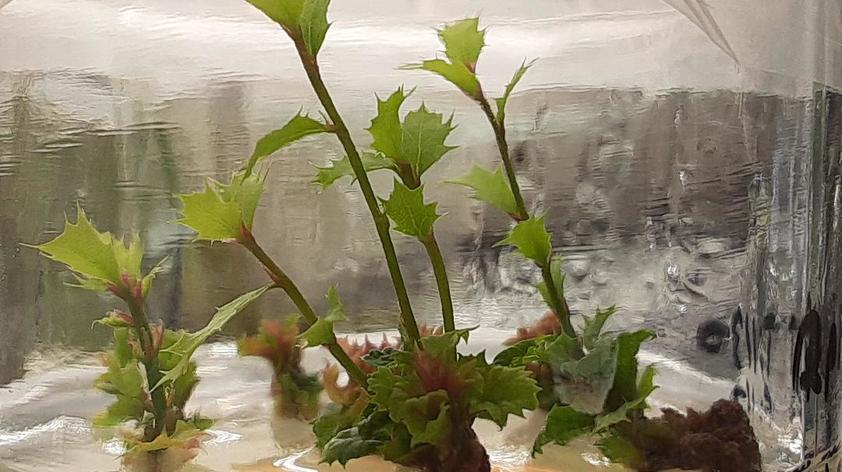
A forest in a jar: Growing whole trees from a single leaf
You can hold an entire orchard in the palm of your hand. Sterilized jars containing a nutrient gel composed of sugar, agar, and fertilizer provide a controlled environment for the cultivation of a forest of plantlets.
Here, these plantlets are free from many of the forces responsible for the destruction of whole populations. Insects cannot sink their mandibles into vulnerable new growth, fungi cannot rot the roots out from under a plant, and fire cannot reduce old-growth forest to cinders. Most importantly, for the endangered coastal sage scrub oak (Quercus dumosa), they also run less of a risk of disappearing under the treads of a bulldozer.
Quercus dumosa is a canopy species of the chaparral. Though the oldest trees measure only several meters high, their boughs stretch out to insulate against the warm sun during summer and against chilling winds during winter. They build networks of deep roots to provide water and to serve as a source of energy to fuel regrowth after a wildfire. Leaves are thick, dry, and adapted to the arid environment. These trees are well suited to survive.
Yet, their populations are declining. Agriculture and urban development have resulted in a series of fragmented populations. The long-term survival of Quercus dumosa is anything but certain.
Hope remains, though.
Throughout the last several decades, researchers around the world have gradually built up the technology of tissue culture into a robust tool of incredible potential. Using something as simple as a leaf, we can create a whole forest if we so choose.
The core principle is this: mimic the plant's natural pathways to reprogram one cell type into another. Plants rely on an incredibly complex system of plant growth regulators to lock their cells into one kind or another. If we change the balance of these growth regulators, we can also change how these cells 'see' themselves.
If you've ever gone to a nursery and picked up a powder or solution to help you root a cutting, then you've exercised this very principle. You've 'encouraged' the cells in that rose, apple, or other plant cutting to forget its original state, become a root cell, and begin to grow whole new roots. In the tissue culture setting, we can use exact measurements to monitor how much of what substance causes change and in what way.
To continue the example further, rooting powder/solution sold by nurseries contain a type of plant growth regulator called auxin. Small concentrations of auxin stimulate root growth. More auxin stimulates random, uncontrolled growth. Yet, at very high concentrations, we see something fascinating: the growth of embryos. These embryos may be cultivated further through additional steps involving other plant growth regulators until they grow into whole new plants.
Conversely, there is a group of similar plant growth regulators called cytokinins, and they are mostly related to shoot growth. The inclusion of this plant growth regulator may encourage cells to form whole new shoots. These shoots must then be cut with a scalpel and placed on a nutrient gel with a small amount of auxin to encourage the growth of new roots. Doing so may result in a healthy, disease-free plant.
To get whole healthy plants, it is, unfortunately, not as simple as changing the amount of auxin and cytokinins. There are numerous other plant growth regulators that interact in a web of interactions.
For another example, most people are aware they can cause fruit to ripen by placing it in a bag with some bananas. This is because the banana gives off a gas called ethylene, which accumulates in a sealed environment – a bag or a tissue culture test jar. This means that the tissue culture environment is in constant flux, and we can only control it through careful observation and experimentation.
Unfortunately, not every individual plant reacts the same to these methods. Some individuals take to these techniques with extreme ease, an orchard's worth of new shoots sprouting from each inoculated leaf.
Others, however, may give not even show the slightest signs of growth under any condition. My goal is to develop techniques that will function for the majority of Quercus dumosa. Once this system is in place, these tissues may then be cryopreserved, effectively helping these forests survive for a long time at temperatures far below freezing.
And it is our hope that, not only can Quercus dumosa be preserved, but, hopefully, many other endangered species as well.













